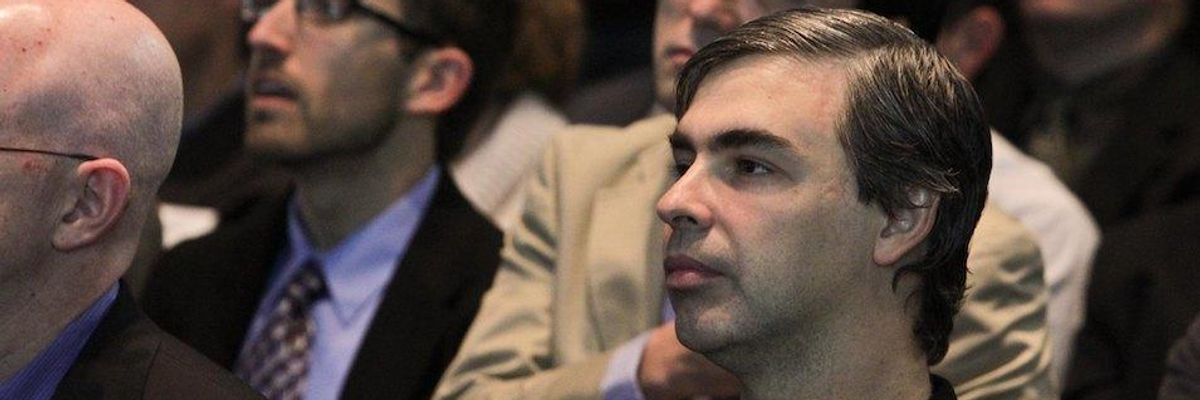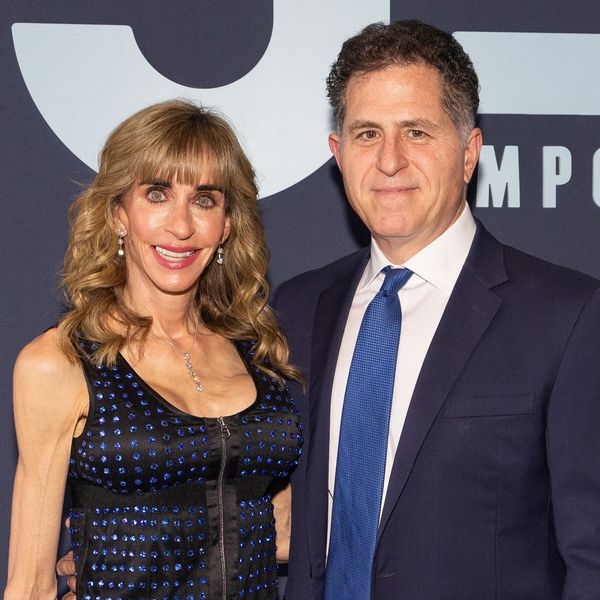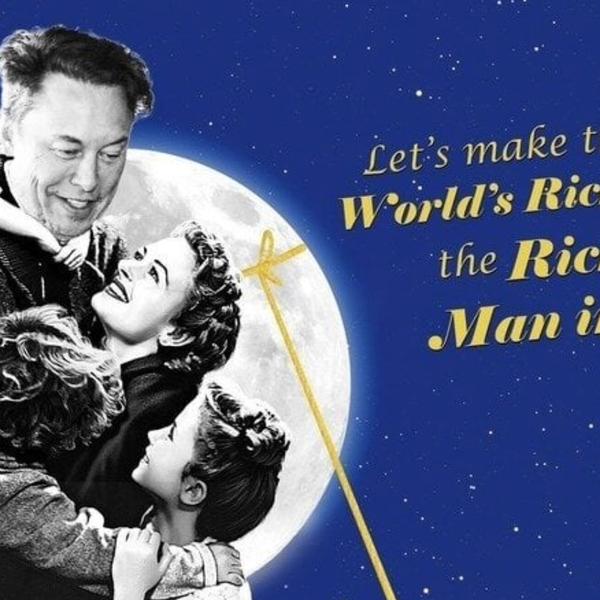
Google billionaire Larry Page, pictured here in 2010, is under fire for his approach to philanthropy. (Photo: Bloom Energy/Flickr/cc)
Google Billionaire Larry Page's $400 Million 'Philanthropic Sleight of Hand' Raises Questions About Charity Loophole
"Not a good look for Larry Page."
Google co-founder and billionaire Larry Page is the subject of a report Wednesday from tech journal ReCode which shows how the Silicon Valley super-rich use workarounds in managing their private foundations that avoid direct contributions to actual charities.
Page's Carl Victor Page Memorial Foundation pushed around $400 million in publicly announced Christmastime donations between 2015 and 2017, but none of it reportedly went directly to charity.
"This a very bad look for Larry Page," tweeted National Committee for Responsive Philanthropy researcher Ryan Schlegel.
As ReCode reporter Teddy Schleifer described in his piece on the billionaire, Page's foundation funnels cash primarily into funds which allow their benefactor a measure of control.
"What Page was doing each year was something of a philanthropic sleight of hand," wrote Schleifer.
Private foundations are required by law to disburse at least 5 percent of their assets a year, a requirement meant to make sure that these taxpayer-subsidized philanthropies actually took part in charity.
But in recent years, Page's foundation has made last-minute donations to hit the threshold only by making bulk donations to separate charitable accounts Page also had some control over, donor-advised funds (DAFs). Those donations technically count as contributions by the foundation, helping it meet the 5 percent standard, even though that money can then sit in the donor-advised funds indefinitely, with no requirement that it goes to needy nonprofits.
"Donations from the foundations to the DAF count toward the 5 percent, even if the DAF then sits on the millions indefinitely," Schleifer added.
The billionaire did donate $21 million from his foundation to charity, but, as ReCode shows, the amount funnelled to DAFs was far greater.
\u201cLove this graphic from @christinamta, which tells the whole story very succinctly. The power of visuals.\n\nhttps://t.co/ELbM6scdkB\u201d— Teddy Schleifer (@Teddy Schleifer) 1576629180
As a result of the DAF system the money in the funds can remain, untaxed, forever. It's a clever tax workaround that uses the specter of altruism to mask a cold calculation over how to hoard capital.
While experts say many charitable foundations use DAFs in a responsible and reasonable manner, ReCode's analysis showed that Page's use of it is in a class of its own.
"It is possible," wrote Schleifer, "that Page is the country's greatest exploiter of this loophole."
Given Page's foundation's size and power, said National Committee for Responsive Philanthropy's Schlegel, the billionaire is not only sitting on tax-free money--he's sitting on power.
"If he wants to avoid public disclosure of the recipients of his largesse he's perfectly free to set up an LLC as some of his very rich peers have done lately," said Schlegel. "But this set up is publicly subsidized influence laundering."
An Urgent Message From Our Co-Founder
Dear Common Dreams reader, The U.S. is on a fast track to authoritarianism like nothing I've ever seen. Meanwhile, corporate news outlets are utterly capitulating to Trump, twisting their coverage to avoid drawing his ire while lining up to stuff cash in his pockets. That's why I believe that Common Dreams is doing the best and most consequential reporting that we've ever done. Our small but mighty team is a progressive reporting powerhouse, covering the news every day that the corporate media never will. Our mission has always been simple: To inform. To inspire. And to ignite change for the common good. Now here's the key piece that I want all our readers to understand: None of this would be possible without your financial support. That's not just some fundraising cliche. It's the absolute and literal truth. We don't accept corporate advertising and never will. We don't have a paywall because we don't think people should be blocked from critical news based on their ability to pay. Everything we do is funded by the donations of readers like you. Will you donate now to help power the nonprofit, independent reporting of Common Dreams? Thank you for being a vital member of our community. Together, we can keep independent journalism alive when it’s needed most. - Craig Brown, Co-founder |
Google co-founder and billionaire Larry Page is the subject of a report Wednesday from tech journal ReCode which shows how the Silicon Valley super-rich use workarounds in managing their private foundations that avoid direct contributions to actual charities.
Page's Carl Victor Page Memorial Foundation pushed around $400 million in publicly announced Christmastime donations between 2015 and 2017, but none of it reportedly went directly to charity.
"This a very bad look for Larry Page," tweeted National Committee for Responsive Philanthropy researcher Ryan Schlegel.
As ReCode reporter Teddy Schleifer described in his piece on the billionaire, Page's foundation funnels cash primarily into funds which allow their benefactor a measure of control.
"What Page was doing each year was something of a philanthropic sleight of hand," wrote Schleifer.
Private foundations are required by law to disburse at least 5 percent of their assets a year, a requirement meant to make sure that these taxpayer-subsidized philanthropies actually took part in charity.
But in recent years, Page's foundation has made last-minute donations to hit the threshold only by making bulk donations to separate charitable accounts Page also had some control over, donor-advised funds (DAFs). Those donations technically count as contributions by the foundation, helping it meet the 5 percent standard, even though that money can then sit in the donor-advised funds indefinitely, with no requirement that it goes to needy nonprofits.
"Donations from the foundations to the DAF count toward the 5 percent, even if the DAF then sits on the millions indefinitely," Schleifer added.
The billionaire did donate $21 million from his foundation to charity, but, as ReCode shows, the amount funnelled to DAFs was far greater.
\u201cLove this graphic from @christinamta, which tells the whole story very succinctly. The power of visuals.\n\nhttps://t.co/ELbM6scdkB\u201d— Teddy Schleifer (@Teddy Schleifer) 1576629180
As a result of the DAF system the money in the funds can remain, untaxed, forever. It's a clever tax workaround that uses the specter of altruism to mask a cold calculation over how to hoard capital.
While experts say many charitable foundations use DAFs in a responsible and reasonable manner, ReCode's analysis showed that Page's use of it is in a class of its own.
"It is possible," wrote Schleifer, "that Page is the country's greatest exploiter of this loophole."
Given Page's foundation's size and power, said National Committee for Responsive Philanthropy's Schlegel, the billionaire is not only sitting on tax-free money--he's sitting on power.
"If he wants to avoid public disclosure of the recipients of his largesse he's perfectly free to set up an LLC as some of his very rich peers have done lately," said Schlegel. "But this set up is publicly subsidized influence laundering."
- Opinion | It’s Time to Move the Money out of Donor-Advised Funds | Common Dreams ›
- Opinion | It's Time for Philanthropists to Get Into Climate Emergency Mode | Common Dreams ›
- Opinion | Real-Life Scrooges Are Hoarding Charitable Donations in Foundations and Funds | Common Dreams ›
- Opinion | How Billionaires Like Marc Benioff Use Philanthropy To Skirt Around Public Scrutiny | Common Dreams ›
Google co-founder and billionaire Larry Page is the subject of a report Wednesday from tech journal ReCode which shows how the Silicon Valley super-rich use workarounds in managing their private foundations that avoid direct contributions to actual charities.
Page's Carl Victor Page Memorial Foundation pushed around $400 million in publicly announced Christmastime donations between 2015 and 2017, but none of it reportedly went directly to charity.
"This a very bad look for Larry Page," tweeted National Committee for Responsive Philanthropy researcher Ryan Schlegel.
As ReCode reporter Teddy Schleifer described in his piece on the billionaire, Page's foundation funnels cash primarily into funds which allow their benefactor a measure of control.
"What Page was doing each year was something of a philanthropic sleight of hand," wrote Schleifer.
Private foundations are required by law to disburse at least 5 percent of their assets a year, a requirement meant to make sure that these taxpayer-subsidized philanthropies actually took part in charity.
But in recent years, Page's foundation has made last-minute donations to hit the threshold only by making bulk donations to separate charitable accounts Page also had some control over, donor-advised funds (DAFs). Those donations technically count as contributions by the foundation, helping it meet the 5 percent standard, even though that money can then sit in the donor-advised funds indefinitely, with no requirement that it goes to needy nonprofits.
"Donations from the foundations to the DAF count toward the 5 percent, even if the DAF then sits on the millions indefinitely," Schleifer added.
The billionaire did donate $21 million from his foundation to charity, but, as ReCode shows, the amount funnelled to DAFs was far greater.
\u201cLove this graphic from @christinamta, which tells the whole story very succinctly. The power of visuals.\n\nhttps://t.co/ELbM6scdkB\u201d— Teddy Schleifer (@Teddy Schleifer) 1576629180
As a result of the DAF system the money in the funds can remain, untaxed, forever. It's a clever tax workaround that uses the specter of altruism to mask a cold calculation over how to hoard capital.
While experts say many charitable foundations use DAFs in a responsible and reasonable manner, ReCode's analysis showed that Page's use of it is in a class of its own.
"It is possible," wrote Schleifer, "that Page is the country's greatest exploiter of this loophole."
Given Page's foundation's size and power, said National Committee for Responsive Philanthropy's Schlegel, the billionaire is not only sitting on tax-free money--he's sitting on power.
"If he wants to avoid public disclosure of the recipients of his largesse he's perfectly free to set up an LLC as some of his very rich peers have done lately," said Schlegel. "But this set up is publicly subsidized influence laundering."
- Opinion | It’s Time to Move the Money out of Donor-Advised Funds | Common Dreams ›
- Opinion | It's Time for Philanthropists to Get Into Climate Emergency Mode | Common Dreams ›
- Opinion | Real-Life Scrooges Are Hoarding Charitable Donations in Foundations and Funds | Common Dreams ›
- Opinion | How Billionaires Like Marc Benioff Use Philanthropy To Skirt Around Public Scrutiny | Common Dreams ›

